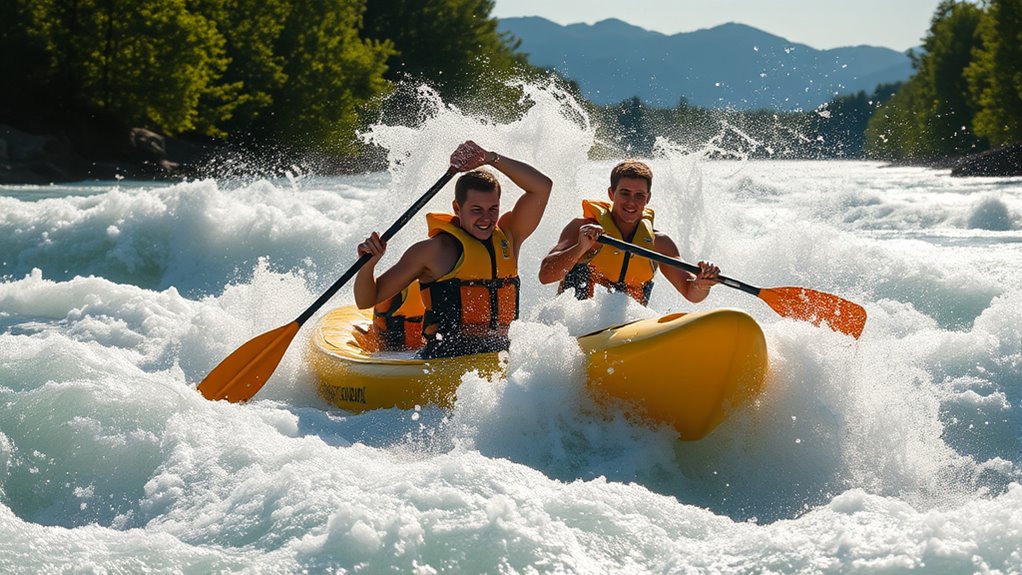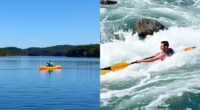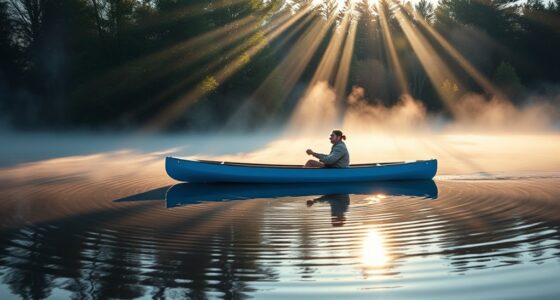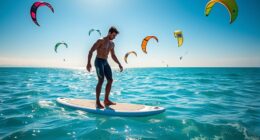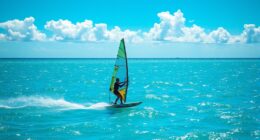When maneuvering rapids in whitewater canoeing, prioritize smooth paddle techniques and wear essential safety gear like a life jacket and helmet. Familiarize yourself with the river’s layout and always keep a buddy with you. Stay alert to changes in water conditions and practice your water-reading skills for quick decision-making. With constant practice and preparation, you’ll build your confidence and skill level. There’s much more to master if you’re enthusiastic to enhance your rapids navigation!
Key Takeaways
- Master efficient paddle techniques like forward strokes and J-strokes for better control while navigating rapids.
- Always wear a life jacket and helmet for optimal safety during whitewater canoeing.
- Familiarize yourself with the river’s layout and plan your route to anticipate challenges.
- Stay alert to changing water conditions and practice reading currents for informed decision-making.
- Paddle with a buddy to enhance safety and support throughout your journey on the river.

Have you ever felt the rush of maneuvering through roaring rapids? The thrill of whitewater canoeing can be addictive, and mastering it requires a blend of skill, technique, and the right safety gear. The moment you push off from shore, your heart races with excitement, but it’s essential to stay focused to navigate the challenges ahead.
First things first, let’s talk about paddle techniques. You need to be adept at using your paddle efficiently to steer your canoe through the tumultuous waters. A common mistake is relying solely on brute force. Instead, focus on smooth, controlled strokes. When you’re approaching a rapid, use a forward stroke to gain momentum and a draw stroke to change direction quickly. Timing is crucial—you’ll want to anticipate the waves and currents. By practicing techniques like the J-stroke, you can maintain a straight path while allowing for quick adjustments. Remember, the more fluid your movements, the easier it’ll be to handle unexpected twists and turns.
Mastering paddle techniques is essential for navigating rapids—focus on smooth strokes, timing, and fluid movements for success.
Now, let’s shift gears to safety gear. Wearing the right safety gear isn’t just a recommendation; it’s a necessity. A well-fitted life jacket should always be your first line of defense. It’ll keep you afloat if you capsize, giving you a fighting chance against the rushing water. Additionally, consider wearing a helmet to protect your head from potential collisions with rocks or your canoe. Footwear is often overlooked but vital. Choose shoes that provide good grip and can handle wet conditions, as slipping can lead to accidents.
Before you plunge into the water, ensure you’ve got a plan in place. Familiarize yourself with the river’s layout, noting areas that might pose challenges. It’s also a good idea to paddle with a buddy. Not only can they help you if you run into trouble, but having a companion makes the experience even more enjoyable.
As you glide through the rapids, stay alert. Watch the water’s surface for changes in the current and be prepared to react. Navigating whitewater isn’t just about technique; it’s about reading the water and making quick decisions. With practice, you’ll develop the intuition needed to tackle even the most challenging sections.
Frequently Asked Questions
What Is the Best Time of Year for Whitewater Canoeing?
The best time for whitewater canoeing typically falls in late spring to early summer. During this period, snowmelt boosts water flow, creating ideal conditions for thrilling rides. When you’re planning your seasonal outings, consider water flow levels, as they can vary markedly based on weather patterns. By keeping an eye on local river reports, you’ll guarantee you’re hitting the water at the right time for the most exhilarating experience.
How Do I Choose the Right Canoe for Rapids?
Choosing the right canoe for rapids is like picking the perfect dance partner; you need stability and responsiveness. Look for a canoe designed for whitewater, featuring a wider hull for stability in turbulent waters. Make certain it has enough rocker to maneuver swiftly. For paddles, select lightweight materials with a sturdy grip, allowing for quick strokes. With the right combination, you’ll glide through the rapids smoothly and confidently, enjoying every exhilarating moment.
Are There Specific Physical Requirements for Canoeing in Whitewater?
Yes, there are specific physical requirements for canoeing in whitewater. You’ll need a good level of physical strength to paddle effectively against currents and maneuver your canoe. Balance skills are also essential; you’ll often face shifting water and obstacles that require quick adjustments. While you don’t need to be a professional athlete, maintaining fitness and practicing your balance can greatly enhance your experience and safety when steering through challenging rapids.
Can Beginners Participate in Whitewater Canoeing Trips?
Yes, beginners can definitely participate in whitewater canoeing trips! Many outfitters offer entry-level trips designed specifically for novices. To guarantee your safety, you’ll receive proper instruction and equipment before hitting the water. It’s important to choose trips that match your skill level and focus on beginner safety. With the right guidance and preparation, you’ll enjoy an exhilarating experience while learning the basics of steering rapids. Go ahead, give it a try!
What Should I Pack for a Whitewater Canoeing Adventure?
When embarking on your whitewater adventure, think of it as your own Odyssey. You’ll need essential safety gear like a personal flotation device and a helmet. Don’t forget navigation tools such as a waterproof map or compass to steer your course. Pack extra clothing, sunscreen, and a first aid kit to handle any surprises. With the right gear, you’ll conquer the rapids and create unforgettable memories while staying safe on the water.
Conclusion
In whitewater canoeing, safety’s always the name of the game. By understanding the currents, reading the water, and using the right gear, you’ll navigate those rapids like a pro. Remember, it’s better to be safe than sorry, so don’t rush into challenging waters without the proper skills. Trust your instincts, stay alert, and you’ll have an unforgettable adventure on the river. So, gear up and get ready to paddle your way to excitement!

